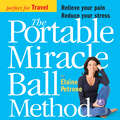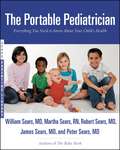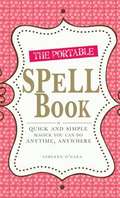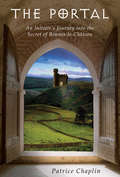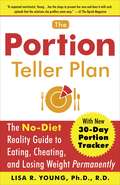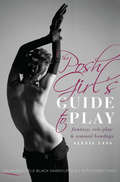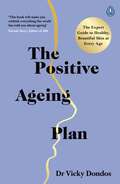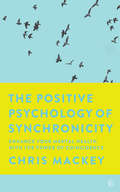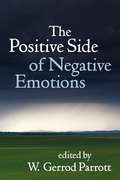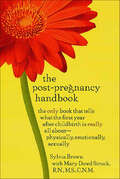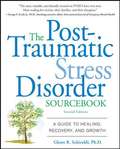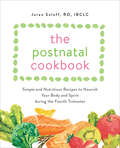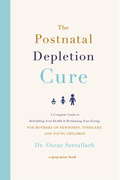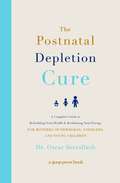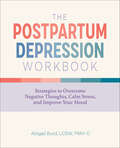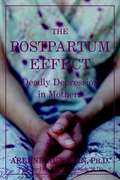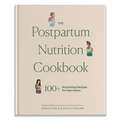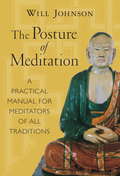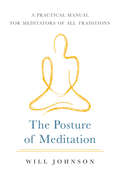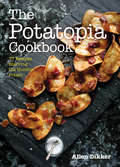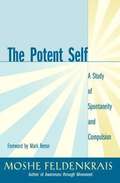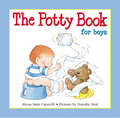- Table View
- List View
The Portable Miracle Ball Method: Relieve Your Pain, Reduce Your Stress
by Elaine Petrone**Note: A Miracle Ball is not included with ebook edition. To purchase a Miracle Ball, please purchase a print edition of The Miracle Ball Method or visit www.elainepetrone.com to purchase a ball separately.** Introducing The Portable Miracle Ball, a book of simple exercises for pain and stress relief with an inflatable Miracle Ball. Ideal for business travelers and commuters or anyone who spends long hours away from home, these exercises require only one ball (which packs easily and is discreet to use in public) and can be done anywhere and everywhere. The fully illustrated book is filled with simple exercises that work miracles the minute you settle into your hotel room or board a plane. Stuck in a long line at the bank? Here are techniques to stretch the muscles and reduce tension right on the spot (and no, you won’t look silly). Feet worn out after a day at the museum? The author’s soothing exercises targeting the insteps and legs will have you up and moving again in no time. And for anyone who experiences discomfort when sitting for long periods, the book features exercises to be performed at your desk, on a plane, or even in a restaurant. A chapter on “Emergency Measures” provides quick relief for back spasms, waking up with extreme stiffness, and other acute problems. The author discusses proper breathing technique, ball placement, and the importance of listening to one’s own body when performing the movements.
The Portable Pediatrician: Everything You Need to Know About Your Child's Health
by William Sears Martha Sears James Sears Robert Sears Peter SearsImagine you are up at three o'clock in the morning with a sick child. Wouldn't it be nice to have expert advice readily at hand to help get you through the night? Encyclopedic in scope, THE PORTABLE PEDIATRICIAN features timely and practical information on every childhood illness and emergency, including when to call the doctor, what reassuring signs can help you know your child is okay, how to treat your child at home, and much more-all in a convenient A-to-Z format. Among the scores of topics covered: teething; sprains and broken bones; nosebleeds; measles; ear infections; choking; rashes; colic; headaches; eating disorders; fever; hip pain; warts; allergies; obesity; seizures; Asperger's Syndrome; bronchitis; masturbation; sunburns; pneumonia; speech delay; lice; vomiting; asthma; heart defects; blisters; sleep problems; and more. The Searses guide parents and caregivers from a child's infancy through the teen years, teaching them what to expect at regular checkups as well as how to boost a child's well-being, devise a family health plan, work effectively with their pediatrician, and more. Distinguished by the Searses' trademark comprehensiveness, reliability, and accessible, comforting one, this book is a must-have for all families who want to keep their children healthy and happy.
The Portable Personal Trainer: 100 Ways to Energize Your Workouts and Bring Out the Athlete in You
by Eric HarrExercise Your Body. Enjoy Yourself. Experience the Difference.Whatever your fitness level, world-class Iron Man triathlete Eric Harr shares 100 inspirational strategies to uncover your passion and improve your performance.•See each workout as a celebration and an opportunity for personal growth (#5).•Stop counting calories and listen to your body for nutrition information it knows what you need (#22).•Learn why morning workouts are best–and it's not just because you’ll burn more body fat (#35) •Experience the power of a “breakthrough session” in your training program (#60).•Find out the five best fat-burning secrets, and why you must be selfish about your fitness.(#s 90 and 91).•Put less effort into your workout for world-class results (#73).•Let go of your ego and rely on your inner strength and confidence (#84).Gleaned from thousands of hours of training and shared wisdom from the very best athletes in the world, these simple lessons will transform your approach to getting fit, staying active, and being alive.
The Portable Spell Book
by Ashleen O'GaeaYou don't need a witch's cauldron to do magick. With this book, casting spells, creating charms, and brewing potions are as easy as wrinkling your nose. Designed for spellcasters on the go who want to practice informal magick without calling attention to themselves, this guide offers quick fixes for everyday problems, such as: Charms to find a soul mate Chants to stay in control during stressful times Quick potions to boost power at work Spells to attract that extra cash for a vacation With simple tools and ingredients, usually found around the house, readers will conjure effective magick to attract only positive elements in their life. This spell book reveals the secrets to practicing magick the quick and easy way!
The Portal
by Patrice ChaplinThe true-life memoir Patrice Chaplin began in City of Secrets continues here in the story of her spiritual initiation into the Kabbalistic tradition preserved since the Middle Ages by a secret society in the pre-Roman city of Girona, Spain. Salvador Dalí was a member of that society, as was the renowned author Umberto Eco, the filmmaker Jean Cocteau, and Jancint Verdeguer, one of the most celebrated Catalan poets. Importantly, so was the mysterious Berenger Sauniere, the priest who in the late 1800s built Rennes-le-Château in southern France, with the Tour Magdala, a tower that is twin to the neo-gothic tower in Girona. In this gripping story that reads like the adventures of a female Castenada, Chaplin is led through a series of initiatory stages which correspond to the magical square of Venus, containing the constellation of the Great Bear.
The Portal
by Patrice ChaplinThe true-life memoir Patrice Chaplin began in City of Secrets continues here in the story of her spiritual initiation into the Kabbalistic tradition preserved since the Middle Ages by a secret society in the pre-Roman city of Girona, Spain. Salvador Dalí was a member of that society, as was the renowned author Umberto Eco, the filmmaker Jean Cocteau, and Jancint Verdeguer, one of the most celebrated Catalan poets. Importantly, so was the mysterious Berenger Sauniere, the priest who in the late 1800s built Rennes-le-Château in southern France, with the Tour Magdala, a tower that is twin to the neo-gothic tower in Girona. In this gripping story that reads like the adventures of a female Castenada, Chaplin is led through a series of initiatory stages which correspond to the magical square of Venus, containing the constellation of the Great Bear.
The Portion Teller Plan: The No Diet Reality Guide to Eating, Cheating, and Losing Weight Permanently
by Lisa R. YoungThe Portion Teller Plan is a sensible eating guide and the end of diet deprivation. No forbidden foods, no calorie counting. Welcome to diet liberation.Would you ever consider going to the kitchen in the morning and grabbing five slices of bread for breakfast? No? Just one bagel is more like it, right? Well, your morning bagel is equivalent to eating five slices of bread. Your steak at dinner is equal to the protein in eighteen eggs. And that huge bowl of pasta you had at lunch is anybody's guess. Nobody likes to cut back but the cold hard facts are in: Portion sizes have steadily increased over the past thirty years and our collective waistlines are ballooning right along with them. You may need to eat a little less if you want to lose weight, but with The Portion Teller Plan you can eat all of your favorite foods. Nutrition and portion size expert Dr. Lisa Young presents an individualized guide to eating according to your portion personality and food preferences. You'll learn a simple system of visuals-a deck of cards, a baseball, your own hand-to help gauge portion size. You'll be able to eat out, eat in, cheat, and eat on the road without ever being a portion victim again.
The Posh Girl's Guide to Play: Fantasy, Role Play & Sensual Bondage
by Alexis LassBecause little black handcuffs go with everything...In The Posh Girl's Guide to Play, Alexis Lass leads you into the romantic and wildly glamorous world of dominance and submission, and engages her lover, Mr. H, to address the interests of your play partner. Blending their his-and-her stories with encouraging, down-to-earth advice, Lass confides how to enter the world of fantasy and enjoy the power and delight of role play-all while feeling safe and sensual. Along the way, she shares insider wisdom on the psychological aspect of this kind of intimacy, including:Establishing trust between partnersThe yoga-like benefits of submission and sensory deprivationExploring secret fantasiesBuilding erotic tensionAdvancing the play (for the adventurous)Tantalizing and intelligent, The Posh Girl's Guide to Play is the perfect beginner's guide to go from "no way" to "let's play!"
The Positive Ageing Plan: The Expert Guide to Healthy, Beautiful Skin at Every Age
by Dr Vicky Dondos'This book will make you rethink everything the world has erroneously told you about ageing' Farrah Storr, Editor of Elle *****When we look in the mirror we want to see a fresh-faced, radiant and confident version of ourselves and Dr Vicky Dondos has spent fifteen years helping her clients see just that. In The Positive Ageing Plan she shares her advice for how you can enjoy an effortless, confident glow, at every age.The aim isn't to look younger, but to look and feel good about yourself and your appearance throughout your life. In this empowering guide, Dr Vicky demystifies the ageing process, reveals the products that are worth investing in and shows you how to create your own personalized programme, so that you can care for your own health and appearance in a way that works for you, your schedule and your budget.The expert advice in this book will help you:- Better understand your own skin- Find the skincare approach that works for you- Learn radiance-boosting lifestyle tips- Get the lowdown on the cosmetic treatments available to you- Above all, appreciate your own natural beautyWhatever your reasons for picking up this book, it is a science-based, straight-talking, judgement-free guide to finding the best options for your skin and will help you grow the confidence that comes with looking great.*****'Tatler's finest ... one of the most rigorous, skilled, clever and charming specialists out there.' Francesca White, Tatler Beauty Editor 'A brilliant book! I thoroughly enjoyed reading it and learned so much. I finished it feeling empowered and in control' Lily Boulle, Founder & Managing Director of Sleep Siren
The Positive Psychology of Synchronicity: Enhance Your Mental Health with the Power of Coincidence
by Chris MackeyFor all those interested in mental wellness as well as mental-health practitioners, this book makes the strongest case yet made that synchronicity and other forms of intuitive insights promote wellbeing and help us transform mental-health issues into personal growth."A profound introduction to deep concepts of mind, meaning and the challenges of creating a life well lived for everyone." - Ernest Rossi, PhD, author of The Psychobiology of Gene Expression and Creating ConsciousnessSynchronicity is meaningful coincidence that connects our inner and outer worlds. This book reveals how it can guide us along our life path, helping us through challenging times and nudging us toward self-fulfilment. Psychologist Chris Mackey writes from personal experience, not only as a practitioner but also as a patient who has suffered serious mental illness. Formerly a rationalist with little time for non-scientific approaches, his own experiences and those of his patients have convinced him that synchronicity has a key role to play in helping us to tap into our intuitive and spiritual selves and guiding us through life. He now passionately believes that we need to embrace transcendent experiences and explore the opportunities for personal development offered by depression and states of mind that are often dismissed as psychosis. This exciting new approach to synchronicity and the treatment of depression and other mental disorders will be of great interest to practitioners and patients alike, as well as to anyone interested in the opportunities offered by altered states of consciousness. The book includes: * Carl Jung's original description of synchronicity * Real-life case studies * Brain science * Practical ways to work with synchronicity including journalling, symbol analysis and dream interpretation.<
The Positive Side of Negative Emotions
by W. Gerrod ParrottThis unique volume brings together state-of-the-art research showing the value of emotions that many believe to be undesirable. Leading investigators explore the functions and benefits of sadness, anxiety, anger, embarrassment, shame, guilt, jealousy, and envy. The role of these emotions in social interactions and relationships is examined, as are cultural differences in how they are valued and expressed. The volume considers how people seek out these feelings in everyday life to improve performance, gain insight, and express cares and commitments. Negative emotions are shown to have an important place in a rich and meaningful life.
The Post-Pregnancy Handbook: The Only Book That Tells What the First Year After Childbirth Is Really All About---Physically, Emotionally, Sexually
by Sylvia Brown Mary Dowd StruckWhile a number of books exist which deal with various aspects of the postnatal experience - breastfeeding, exercise, motherhood, post-partum depression - this is the first complete source of information on what a woman experiences both physically and emotionally in the days, weeks and months after childbirth. It is also the only book in its field which balances medical advice with practical tips and numerous references to alternative remedies. From Sylvia Brown, a mother, and Mary Dowd Struck, RN,MS,CNM, a nurse/midwife, comes The Post-Pregnancy Handbook, a wonderfully comprehensive, honest self-help guide which every new (and repeat) mother should keep by her bedside. Brown and Struck give detailed guidance on: The First Few Days - alleviating discomfort from the after-effects of labor or a ceasarian - making the hospital stay more pleasant- coping with possible medical complications The First Few Weeks - organizing home life with a new baby - surviving fatigue- breastfeeding successfully - managing older siblings, parents and friends- introducing a new dimension to the couple (returning to sex after childbirth)- navigating the new mother's dietary needs- identifying and overcoming a range of emotional difficulties from "baby blues" to severe postnatal depression- dealing with stress, guilt and that elusive maternal instinct The First Year- achieving a complete physical recovery: how to get back into shape from the inside out - restoring strength and tone to the pelvic floor- countering the legacies of pregnancy: problems with hair, skin, and varicose veinsA thorough, straightforward guide to helping the new mother achieve an effective and harmonious recovery.
The Post-Traumatic Stress Disorder Sourcebook
by Glenn R. SchiraldiTrauma can take many forms, from witnessing a violent crime or surviving a natural disaster to living with the effects of abuse, rape, combat, or alcoholism. Deep emotional wounds may seem like they will never heal. However, with The Post-Traumatic Stress Disorder Sourcebook, Dr. Glenn Schiraldi offers a remarkable range of treatment alternatives and self-management techniques, showing survivors that the other side of pain is recovery and growth. Live your life more fully-without fear, pain, depression, or self-doubt Identify emotional triggers-and protect yourself from further harm Understand the link between PTSD and addiction-and how to break it Find the best treatments and techniques that are right for you This updated edition covers new information for war veterans and survivors with substance addictions. It also explores mindfulness-based treatments, couples strategies, medical aids, and other important treatment innovations.
The Postnatal Cookbook: Simple and Nutritious Recipes to Nourish Your Body and Spirit During the Fourth Trimester
by Jaren SoloffReplenish and rejuvenate your postpartum body with these seventy-five easy, healing, and protein-rich recipes designed with new moms in mind.If you’re a new or expecting mother, you probably know how important nutrition is during pregnancy. But you should pay just as much attention to nutrition in the fourth trimester, a vitally important time for recovering from your major physical and emotional journey.The delicious recipes in The Postnatal Cookbook are specifically formulated for a new mom’s nutritional needs. You’ll learn how to replenish and rejuvenate your postpartum body with uncomplicated, healing, and satisfying recipes like:Sweet Potato Breakfast BowlsRoasted Tomato and Fennel SoupHerb Baked SalmonQuick Chicken CurryGarlic HummusChia PuddingCrafted by a registered dietitian and lactation consultant, these recipes are paired with nutritional information and thoughtful tips for easy prep to help you nourish your body and thrive in the postpartum period!
The Postnatal Depletion Cure: A Complete Guide To Rebuilding Your Health And Reclaiming Your Energy For Mothers Of Newborns, Toddlers And Young Children
by Dr Oscar SerrallachIt's all too common to hear new mums talk about 'baby brain' and extreme fatigue. But what if it wasn't the physical toll of giving birth, breastfeeding or chasing a toddler that was sapping your strength? What it if was something deeper? Dr. Oscar Serallach has spent his medical career witnessing women fail hormonally, nutritionally and emotionally to get back on their feet after having a baby. The true cause? A syndrome he calls postnatal depletion. THE POSTNATAL DEPLETION CURE is the first book to name the syndrome and to offer a practical programme to help mothers replenish their bodies after having a baby. The book includes a comprehensive guide to the nutrients women need to enhance organ function and balance hormones, along with advice on how to maintain a healthy diet and exercise routine and get necessary rest, despite the demands of motherhood. Filled with prescriptive takeaways and many success stories, THE POSTNATAL DEPLETION CURE will help mothers be the best they can be physically and emotionally.
The Postnatal Depletion Cure: A Complete Guide to Rebuilding Your Health and Reclaiming Your Energy for Mothers of Newborns, Toddlers, and Young Children
by Dr. Oscar SerrallachWhile postpartum depression has become a recognizable condition, this is the first book to treat root causes of mommy brain, baby blues, and other symptoms that leave mothers feeling exhausted. Any woman who has read What to Expect When You're Expecting needs a copy of The Postnatal Depletion Cure. Filled with trustworthy advice, protocols for successful recovery, and written by a compassionate expert in women's health, this book is a guide to help any mother restore her energy, replenish her body, and reclaim her sense of self. Most mothers have experienced pain, forgetfulness, indecision, low energy levels, moodiness, or some form of baby brain. And it's no wonder: The process of growing a baby depletes a mother's body in substantial ways--on average, a mother's brain shrinks 5% during pregnancy, and the placenta saps her of essential nutrients that she needs to be healthy and contented. But with postnatal care ending after 6 weeks, most women never learn how to rebuild their strength and care for their bodies after childbirth. As a result, they can suffer from the effects of depletion for many years, without knowing what's wrong as well as getting the support and treatments that they need.
The Postpartum Depression Workbook: Strategies to Overcome Negative Thoughts, Calm Stress, and Improve Your Mood
by Abigail BurdPowerful strategies and compassionate support for overcoming postpartum depressionBecoming a parent is a huge transition. For some, the mood swings, the pressures, and the anxiety can be intense and overwhelming. One in five women will develop postpartum depression (PPD) after pregnancy—so if you're struggling with PPD, know you're not alone. This depression workbook is designed to help you navigate the transition to becoming the healthy and happy parent you want to be.This depression workbook is here to guide you on your journey, providing supportive strategies and tools grounded in cognitive behavioral therapy (CBT)—proven to help you understand, cope with, and reduce your PPD symptoms. Discover common signs of PPD, what it is, and what you can do about it. Explore your thoughts, feelings, and relationships, plus self-care practices through a variety of practical and insightful exercises in this depression workbook.This depression workbook includes:Primer on PPD—Discover if you might have PPD, take a look at common causes and risk factors, and see how PPD can impact your partner.Lasting relief—The CBT-based postpartum strategies in this depression workbook will help you adopt a positive mindset, improve your mood, deepen your relationships, and find time to recharge.Parents like you—Find kinship in real-life scenarios from other parents, paired with practical advice, simple tips, and interactive exercises.This depression workbook provides the strategies, tools, and support you'll need for a healthy and happy transition into parenthood.
The Postpartum Effect: Deadly Depression in Mothers
by Paul J. Goodnick Arlene M. HuysmanThe past decade has seen strides in the diagnosis and treatment of postpartum depression, which affects 400,000 women annually in the United States. Yet the most tragic of these cases--the filicides and suicides that spark tabloid frenzy--continue to be horribly misdiagnosed. Dr. Arlene Huysman, drawing on decades of clinical work, here describes the postpartum effect, the missing key to treatment.Dr. Huysman's book is designed to educate the general public, and to serve as a tool in the care provider's hands. In The Postpartum Effect the author records anonymous first-person testimonies from mothers who were tempted to harm their children. She constructs a profile of mothers at greatest risk of the disease. All leading up to the central question: What drives a mother to the ultimate travesty? Dr. Huysman's measured, empirical approach is a plea for understanding.
The Postpartum Nutrition Cookbook: Postpartum Gifts for Mom
by Diana Licalzi Ashley ReaverThe essential postpartum recovery guide and cookbook to help new moms replenish their bodies with 100+ easy, nutrient-packed recipes, plus meal plans and shopping listsThe postpartum period brings major physical and emotional changes for new moms. While caring for a newborn is difficult, it's critical that mothers focus on replenishing their bodies after pregnancy, childbirth, and breastfeeding.Most postpartum resources focus on how to care for the baby, but The Postpartum Nutrition Cookbook—written by registered dietitians Diana Licalzi and Ashley Reaver—prioritizes the mom's self-care first. This book guides new moms through recovery during the 4th trimester, highlighting key nutrients needed to heal and restore their bodies.The Postpartum Nutrition Cookbook features:100+ simple, delicious recipes catered to postpartum nutrient needsMake-ahead breakfasts, one-handed lunches, and set-it-and-forget-it dinnersHelpful trackers, grocery shopping lists, and targeted nutrition adviceEasy meal-prepping tips and techniques for busy new momsGuidance on making self-care and proper nutrition a priorityThis one-of-a-kind resource equips new moms with everything they need to nourish themselves and their families in the critical postpartum period. Friends, relatives, or partners can also use this guide when looking to support a new mother with nourishing meals and self-care. Consider it a trusted companion during the challenging but precious early weeks and months of motherhood.
The Posture of Meditation
by Will JohnsonWhen it comes to meditation practices, the body is as important as the mind--a fact that may come as a surprise to the many people who regard meditation as a strictly mental activity. But, as Will Johnson shows, the physical aspect of the practice is far too often underemphasized. The alert-yet-relaxed sitting posture that is the common denominator of so many meditative techniques is a wonderful aid for clearing the mind and opening the heart, but it also works to activate the natural healing energies of both body and mind. The author offers guidance and exercises for working with the posture of meditation and advice on how to carry its benefits on into all the rest of life.
The Posture of Meditation: A Practical Manual for Meditators of All Traditions
by Will JohnsonWhen it comes to meditation practices, the body is as important as the mind—a fact that may come as a surprise to the many people who regard meditation as a strictly mental activity. But, as Will Johnson shows, the physical aspect of the practice is far too often underemphasized. The alert-yet-relaxed sitting posture that is the common denominator of so many meditative techniques is a wonderful aid for clearing the mind and opening the heart, but it also works to activate the natural healing energies of both body and mind. The author offers guidance and exercises for working with the posture of meditation and advice on how to carry its benefits on into all the rest of life.
The Potatopia Cookbook: 77 Recipes Starring the Humble Potato
by Allen Dikker&“Fantastic, unique recipes . . . Whether you want to accent your favorite meal with a potato dish or make an exciting main dish.&” —Broadway World Latkes. Gnocchi. Aligot. Knishes. Samosas. Munini-imo. Poutine. Potatoes—consumed globally at a rate of about sixty-eight pounds per capita each year—are the stars of some of the world&’s most beloved dishes. Perhaps this is why most of us tend to underestimate the humble tuber—it&’s so familiar that we forget its full potato potential. Enter The Potatopia Cookbook, a collection of more than seventy-five creative potato recipes from Allen Dikker, the CEO and founder of Potatopia, the fast-casual all-potato restaurant that has been featured by the New York Times, the Village Voice, and Eater.com, among others. While the cookbook includes some traditional potato dishes like gnocchi and shepherd&’s pie, most recipes are innovative creations that reimagine the world&’s most popular vegetable. Ever thought to make lasagna with paper-thin potato slices instead of noodles? Or prepare truffles with mashed potatoes? Find it all in The Potatopia Cookbook alongside detailed descriptions of potato varieties, potato history, and potato preparation and storage tips. As an added bonus to their popularity, potatoes are naturally gluten-free and—when prepared simply—very nutritious. Along with being fat-, sodium-, and cholesterol-free, potatoes are packed with vitamins, minerals, and antioxidants. As he did with Potatopia&’s menu, Dikker highlights these benefits in the cookbook by focusing on recipes that skip the fat in favor of keeping it healthy. The result is a hearty, wholesome celebration of all things potato. &“A culinary journey guided by the simple, often underappreciated tuber.&” —Foreword Reviews
The Potent Self: A Study of Spontaneity and Compulsion
by Moshe FeldenkraisAuthor is a scientist who pioneered the field of mind-body education and therapy. The book emphasizes emotional and neuromuscular linkages.
The Potential Consequences of Public Release of Food Safety and Inspection Service Establishment-Specific Data
by Committee on a Study of Food Safety Other Consequences of Publishing Establishment-Specific DataThe Food Safety and Inspection Service (FSIS) is the regulatory agency in the US Department of Agriculture that is responsible for ensuring that meat, poultry, and processed egg products produced domestically or imported into the United States are safe, wholesome, and properly labeled. FSIS collects a voluminous amount of data in support of its regulatory functions, but the two major types of FSIS data that are currently being considered for public release are sampling and testing data (derived from standard laboratory tests) and inspection and enforcement data (derived from text written by inspectors). Some of those data are already released to the public in aggregated form but not in disaggregated, establishment-specific form. In recent years, the Obama administration has implemented measures to facilitate openness in government, including the requirement that federal agencies publish information online and provide public access to information in a timely manner; in a form that can be easily retrieved, downloaded, indexed, and searched with tools that are available on the Internet; and without the need for Freedom of Information Act (FOIA) requests. The Potential Consequences of Public Release of Food Safety and Inspection Service Establishment-Specific Data examines the potential food-safety benefits and other consequences of making establishment-specific data publicly available on the Internet. The report includes how factors such as level of aggregation, timing of release, level of completeness, and characterization of the data or context in which the data are presented might affect their utility in improving food safety. The report also examines potential ways that food-safety benefits and other effects of publicly posting the data might be measured.
The Potty Book for Boys (Hannah & Henry Series)
by Alyssa Satin CapucilliEvery little boy's graduation from diapers to the potty is always a very important moment—and one to make both parents and toddlers proud! The Potty Book is a gentle and humorous toddler potty training book, charmingly illustrated and told in rhyming verse - perfect for fans of Sandra Boynton or Let's Go to the Potty!Henry needs to have his diapers changed so he can go out and play. Then mom and dad bring home a big box, and Henry is anxious to open it up and see what's inside. Is it a rocking chair? A bed for Teddy? No, it's a potty—which means that it's time for Henry to graduate from his diapers. Little boys will enjoy looking at the cute pictures while having the story read to them. Meanwhile, they'll start getting the idea that it's time for them to grow up, exactly like Henry. So that at last, they'll be able to say—"I'm off to the potty!"
